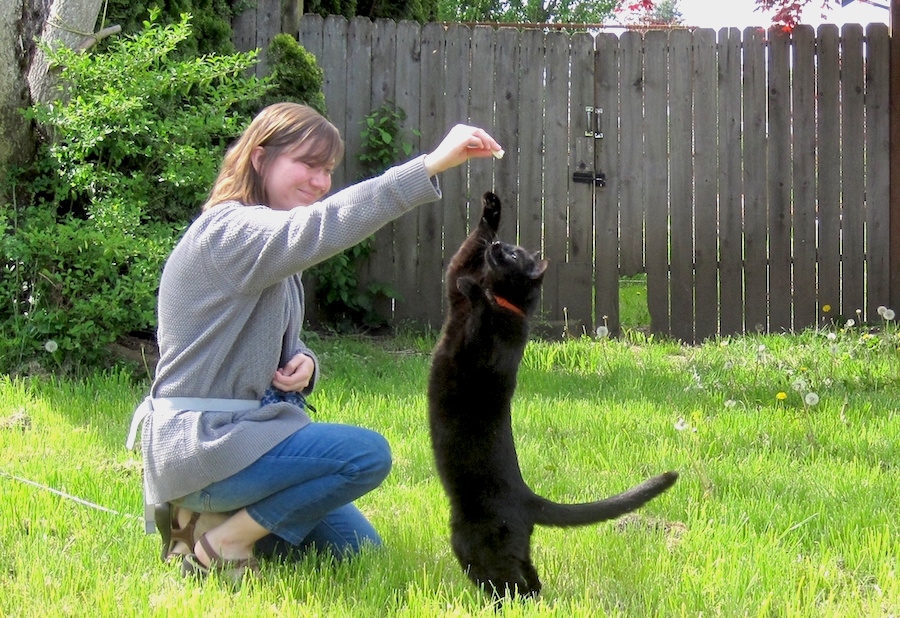How a trifecta of entrepreneurs, scientists and environmentalists are driving a booming new market for cat products.
Roar, a cat boutique that opened last year in Northeast Portland, is a temple to the civilized feline. The store features cat leashes, cat-carrying backpacks and bright collars to warn off birds. A flyer promotes chicken coop-like outdoor “catios.” To enliven these backyard enclosures, Roar offers crude mock-ups of outdoor hunting.
 The Roar cat boutique | Caleb Diehl
The Roar cat boutique | Caleb Diehl
One of a growing number of cat-centric businesses in Oregon, Roar reflects the contradictory nature of cats: They live in our homes and eat our food, yet inhabit a nether space between the wild and the domestic.
Unlike dogs, cats basically domesticated themselves, slaying mice at will, and enjoying the kind of unchecked freedom a (leashed) canine could only dream about. Unlike dogs, today’s housecats still bear the same genetic and physical imprint as their historic counterparts, dating back thousands of years.
But if housecats decided on their own to hang around people, modern culture is ramping up the cat-human relationship. Sure, cat videos and crazy cat people have been around forever. But say hello to a new 21st-century cat management scheme, one that seeks to further contain a cat’s essential wild nature.
“There’s a trend toward getting cats outside in a safe way,” says Laura Cochrane, Roar’s co-owner and a former veterinarian. “There’s more of an awareness of our responsibility for cats.”
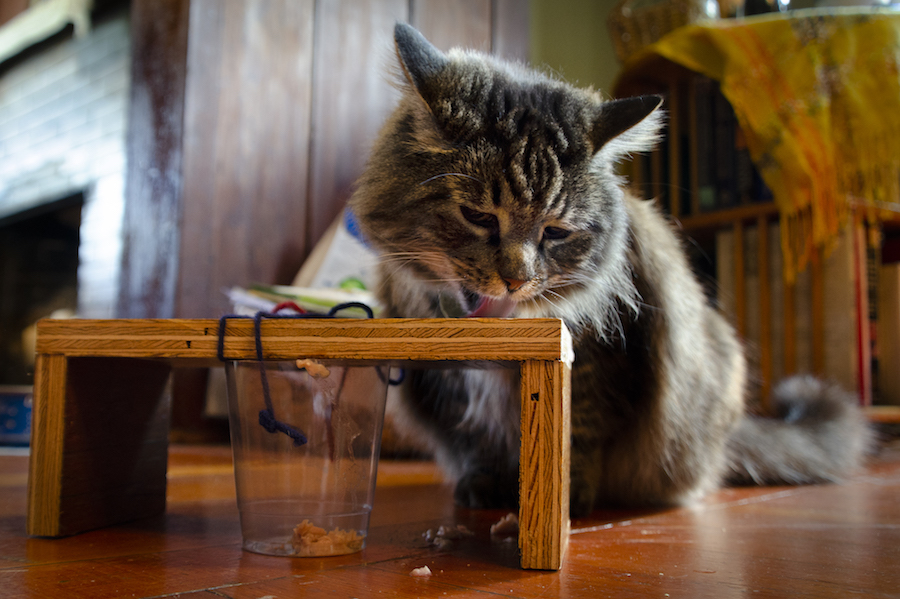 A cat participates in a behavior test at OSU’s cat-human interaction lab. | Kristyn Vitale
A cat participates in a behavior test at OSU’s cat-human interaction lab. | Kristyn Vitale
Inside a nondescript brick building at Oregon State University, a Spartan room houses one of the nation’s only cat cognition labs. There’s a special fridge for animal food, a litter box and a Macbook that streams video of experiments conducted in the adjoining room.
On a recent Wednesday morning, researchers Monique Udell and Kristyn Vitale conduct an attachment experiment. A 13-year-old grey domestic shorthair, Lily, climbs out of a purple carrier and sits with his owner, Alex, in a meter-wide circle taped on the floor. They sit for two minutes, and then Alex leaves the room.
The next part of the experiment tests the team’s stoicism. For another two minutes, everyone watches and listens as Lily stares at the door and meows 51 times (the record is 65).
When Alex returns, the researchers watch the camera to see how Lily responds. Is she angry at Alex? Or is she clingy and afraid he will leave again? Another possibility: Lily moves about the room after greeting Alex, exhibiting “secure attachment.”
Lily displays the second behavior, what the researchers call “ambivalence.”
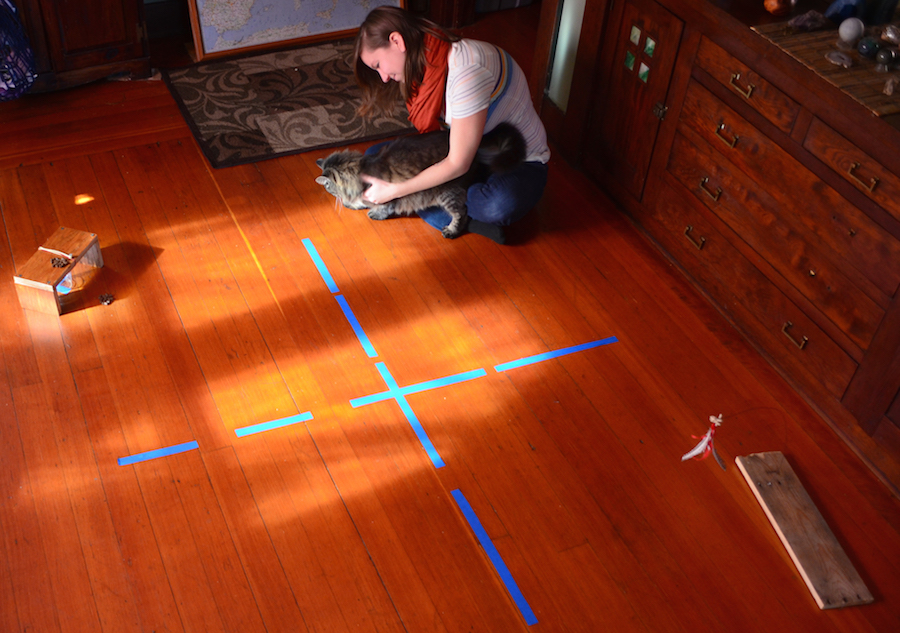
A cat undertaking a preference test with Vitale | Kristyn Vitale
Vitale shows off other videos from the lab’s training course that show cats walking in tight circles on leashes and jumping for treats.
Watching the clips can be a bit disconcerting. Training felines seems to compromise the very essence of cat-ness. Revered as Egyptian deities, left to cleanse rats from the rigging aboard Viking longships, cats have historically been defined by their independence. Unlike dogs, they don’t need humans to care for them.
Few have questioned that premise, until now. “It would be unthinkable to get a puppy and not train them to walk on a leash,” Udell says. “Yet we do that to cats all the time.”
According to Udell, our preference for training the research lens on man’s best friend boils down to evolutionary biology and a dash of luck. Around 10,000 years ago, farmers began storing grain. Cats, of their own accord, swooped in to kill the rodents that threatened the goods. Their instinctive role required no on-the-job training.
Dogs on the other hand, were valued for less lethal missions: flushing birds or corralling sheep. “With dogs you wanted a lot more control,” Udell says, “you don’t want them to actually kill the thing and eat it.”
Dogs were easier to train than cats, and more comfortable in unfamiliar settings, like the lab. Consequently, dogs became proxies for human behavior (think Pavlov). Recently, cat science has begun to catch up. Oregon is helping drive the trend. There are only a handful of cat cognition labs worldwide: two in the United Kingdom, one in Switzerland, one in Japan and one in Corvallis.
Udell has seen an uptick in cat-focused Ph.D candidates and academic cat conferences. Funding follows function, and interest is growing in employing cats — to sniff for drugs and bombs, guide blind people or comfort patients. There’s no reason cats can’t accomplish these tasks, Vitale and Udell say.
“There are a lot of assumptions about what cats like,” Vitale says, “but that’s coming from a human perspective.”

Lily mills around the cat-human interaction lab after participating in an attachment test. | Caleb Diehl
The upshot: Cats are more social than we think. They miss you when you leave for work. They require enrichment, support and training, just like dogs.
And in today’s pet-centric culture, dogs and cats both have become a part of the family, where they are treated like kids, human kids.
The American Pet Products Association estimates Americans will spend $72.13 billion on their pets in 2018, up from $69.5 billion in 2017. Amazon pet product sales have reached $2 billion, up 40% from 2015. Over a year, the average cat owner spends around $30 on toys, $56 on treats and a whopping $235 on food.
Humanization has been one of the factors driving the booming industry. In a recent market report, the Nielsen research group observed that “the humanization of pets has played well for brands and retailers that have developed or pivoted their strategies for consumers looking to treat their furry friends to the best that life has to offer.”
Portland, ranked for years as one of the country’s most dog-friendly cities, has long been ground zero for humanization: The city boasts dozens of doggie day cares, dog specialty stores, dog spas, dog playgrounds and canine-friendly eateries.
Now the market trend has hit the cat industry.
Pet food manufacturer Nestle Purina funds most of OSU’s cat-human interaction research. “They aren’t necessarily looking to promote products,” Udell says. “They let the science say what the science says.”
Purina’s hands-off approach falls in line with other influencer and branded content marketing strategies. But trainable cats open up new product opportunities that align with demographic categories. Middle-aged women have always been a key cat demographic. Now millennials are joining the throng, as they marry later and view pets as stand-ins for kids.
 Laura Cochrane in her Alberta Street cat retail store, Roar. | Caleb Diehl
Laura Cochrane in her Alberta Street cat retail store, Roar. | Caleb Diehl
If cats are the new children, they also demand activities — and products to support those activities. #Adventurecats scale mountains, sleep in tents or float in kayaks.
In the city, a cat’s social calendar is jam-packed. They can mix at a “cat club” hosted by the cat-human interaction lab, stroll through Laurelhurst Park on “First Caturday,” mingle at a cat cafe or indulge at a luxury cat hotel.
 Trinket, a guest at Meowhaus, a cat hotel on Sandy Boulevard | Caleb Diehl
Trinket, a guest at Meowhaus, a cat hotel on Sandy Boulevard | Caleb Diehl
If anyone could be described as a cat lady, it would be Anya Stites, owner of four cats and two Sandy Boulevard cat hotels. Stites opened her first location, Meowhaus One, in 2012. The second opened in 2017 and features 17 spacious rooms with scratching posts, memory foam beds and staircases leading to skyboxes. The establishment, Stites says, caters largely to middle- to upper-class white women and families between the ages of 45 and 65. A wide array of clients, however, come from the surrounding diverse neighborhoods. Rooms run $30 a night, and some animals stay as long as four months.
“Cats are not the second-class citizens they used to be,” Stites says, cradling one guest, longhaired Trinket, like a baby.
Around twenty years ago, she says, owners began ushering cats inside and opting for hotels, instead of neighbors, to meet their cats’ medical and behavioral needs. The upscale boarding houses perform well, Stites says, in affluent cities like Vancouver, B.C. and Los Angeles.

Anya Stites, owner of cat hotel Meowhaus, with one of her guests, Trinket | Caleb Diehl
Stites, a veterinary technician, sees herself as a cat whisperer, changing the environment to suit her guest’s diverse personalities. Some cats prefer solitude, blankets over their windows and no roommates. Others are more gregarious, reveling in the playtime provided daily by part-time “kitty cuddlers.” Stites keeps a spreadsheet with detailed behavior notes on each guest.
Another cat-focused enterprise, Purringtons Cat Lounge on Martin Luther King Boulevard, serves as a middleman between cat shelters and foster parents. It plays matchmaker by arranging socials with nauseating names like “purr yoga” and “meowvie night.” Patrons commune with the eight to eleven resident cats over craft beer and cider.
Portland’s population boom and pet fixation fuels a steady customer base. “We thought Portland was crazy enough we could do it,” says Kristen Castillo, who co-owns Purringtons with her husband Sergio.
Customer demographics “are kind of all over the map,” says Castillo, who advises more than 40 nascent cafes around the country. ”Everybody loves kitties and nachos.”
 Two cats meet at Purringtons Cat Cafe on Martin Luther King Boulevard. | Caleb Diehl
Two cats meet at Purringtons Cat Cafe on Martin Luther King Boulevard. | Caleb Diehl
In the 1970s kids used to play outside without adult supervision. Today, studies show, young children are rarely unaccompanied by adults, and their movement is tightly controlled. The same is true for dogs. Canines used to roam, untethered, around cities. Not anymore.
Now cats are falling into line.
For good reason, many environmentalists say. However cute and anthropomorphic cats might be, they are, in a word, killers, murderers of wild birds.
Smithsonian magazine ballparks the nationwide death toll of song birds at 2.4 billion. Bob Sallinger, conservation director at the Portland Audubon Society, oversees the “Cats Safe at Home” program, the advocacy group’s response to that alarming statistic.
The tally hardly matters anymore, he says. It’s like the national debt: an incomprehensibly massive and growing figure.
In many places, animal lovers define themselves as cat people or bird people, like Bloods and Crips, Montagues and Capulets. Resentment festers on both sides. “You’d be upset if somebody was shooting wildlife in your neighborhood,” Sallinger says, referring to the role cats play as lethal predators.
Vitale counters by saying cats have served as scapegoats for humans’ environmental footprint. Dogs also terrorize the environment, she notes. While cats kill more wildlife in specific areas, dogs threaten a wider swath of territory, according to a 2017 paper by researchers at Southern Illinois University.
Some devout cat lovers, Cochrane and Vitale included, object to keeping cats inside all the time.
Barring cats on leashes, that’s exactly what birdwatchers want.
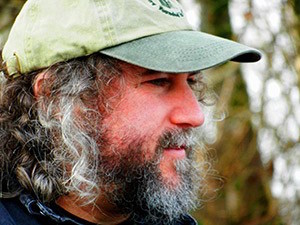 “A lot of the messaging was rigid,” Sallinger says. “It was: Keep your cat indoors. In fact, people have different capabilities in terms of what they can do with their cats.”
“A lot of the messaging was rigid,” Sallinger says. “It was: Keep your cat indoors. In fact, people have different capabilities in terms of what they can do with their cats.”
Yes, Sallinger owns a cat, and yes, he keeps it inside. But he knows that’s not for everyone.
In this respect, as in many others, Portland is weird. The city boasts an unusual cat-bird alliance, brokered in part by Sallinger. The Cats Safe at Home program works in concert with the Feral Cat Coalition of Oregon, a nonprofit that seeks to reduce the number and improve the health of Oregon’s wild cats.
National media portray Sallinger as a mediator who bridged the impossible chasm. Audubon even released a survey, he says, showing that on many conservation issues, Portland’s cat and bird advocates tend to have more in common with each other than the general public.
Inside Roar, Cochrane picks up a Cats Safe at Home brochure from the windowsill. She reads its tenets aloud, and nods approval. Keep cats inside whenever possible, the pamphlet advises, but enrich the indoor environment to reflect cats’ natural outdoor setting. Some cats, including recently rescued strays, need outdoor time. They can venture outside with the aid of leash, backpack or stroller.
Other cats can enjoy the outdoors from the safety of a “catio.” Jim Petrov, a lifelong carpenter and owner of ConstructionReConstruction, says three years ago, he had never heard that portmanteau. Now the wire and wood backyard enclosures account for a third of his business. “People are calling me all the time,” he says.
Ironically, some cat adoption organizations in Portland prefer and sometimes require owners to keep their cats indoors — to protect them from predators like coyotes and raccoons.
 A cat perched in its skybox at Meohaus. Catios offer a similar enclosure with features that mimick outdoor environments | Caleb Diehl
A cat perched in its skybox at Meohaus. Catios offer a similar enclosure with features that mimick outdoor environments | Caleb Diehl
“Every catio is different,” Petrov says. His offerings range from $1,200 deck enclosures to $4,000 palaces that dominate half the backyard. Cats Safe at Home funds part of its operations through an annual “catio tour” of Portland’s feline digs.
To accessorize freshly built catios, Roar offers perches, the “egg-cercizer” (an oval-shaped food puzzle) and a variety of fake mice and snakes. The fat cats in the $4,000 catios can wear cat bow ties, smoke cat cigars and look down at the proletariat cats next door.
“I think there’s a real opportunity here,” Sallinger says. “This is an opportunity to market a solution that’s good for cats and good for wildlife.”
How will Sallinger measure success? As with many conservation campaigns, the ultimate goal remains out of reach. There are too many cats, and not enough ways to track what they’re doing, or what their owners think they should do. Sallinger aims instead at a consistent decline in bird kills and a measurable change in owners’ attitudes.
“Understanding whether you’re having an impact has always been the challenge,” he says. “Are you really changing anything at the end of the day?”
If Sallinger and the cat folks can preserve their alliance, they can solve an enormous management problem. And as he points out, regulation creates new markets.
The Castillos’ recent trip to Los Angeles for CatCon Worldwide — like ComicCon for cats — made it clear that anthropomorphizing cats is big business. “It was overwhelming,” Sergio says. “There are so many cat products now.”
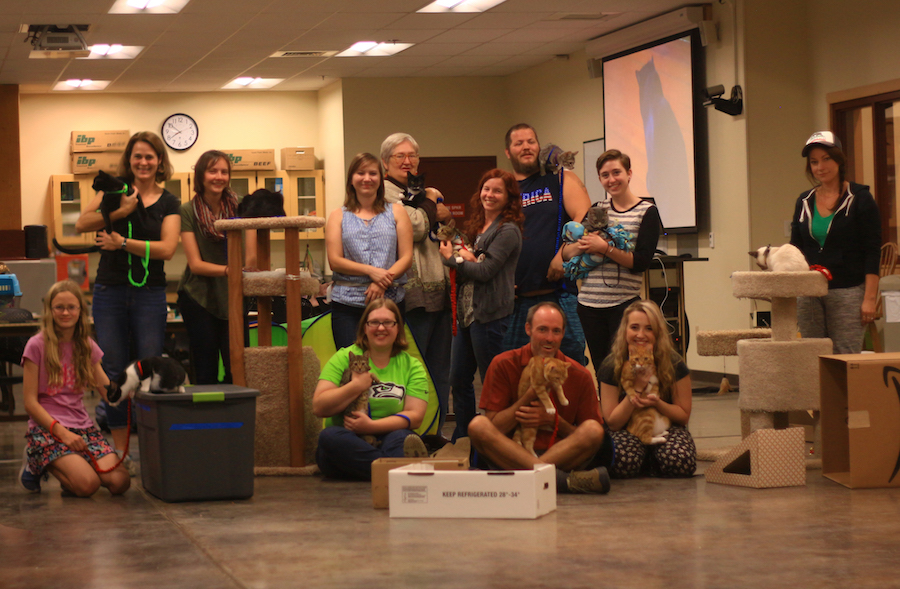 One of Oregon State University’s cat training classes | Kristyn Vitale
One of Oregon State University’s cat training classes | Kristyn Vitale
The new market indicates a cultural shift. Cat used to roam freely around neighborhoods, killing pests and wildlife along the way. Unlike dogs, they did not worship their owners.
That relationship is changing as we limit cats’ freedom of movement. Housecats are moving indoors, where we lavish them with attention and consumer products. Cats on leashes may soon be the norm. And far enough down the road, we might even alter cat genetics, as we nudge our pets out of the liminal space between feral and domestic.
Cats, like many of us, are becoming more environmentally-responsible — and far less wild.
This article has been edited to clarify that the clientele at Meowhaus includes a diverse mix of people, not just affluent Caucasion women.
To subscribe to Oregon Business, click here.


